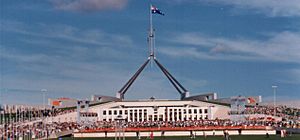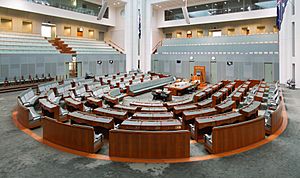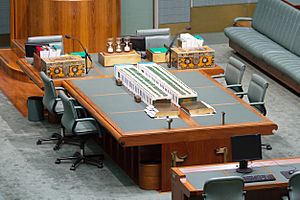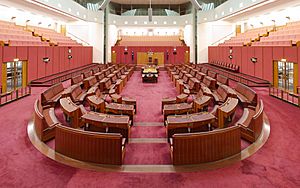Parliament House, Canberra facts for kids
Quick facts for kids Parliament House |
|
|---|---|

The main entrance at blue hour
|
|
| General information | |
| Architectural style | Modern |
| Location | Canberra, Australian Capital Territory |
| Country | Australia |
| Coordinates | 35°18′29″S 149°07′28″E / 35.30806°S 149.12444°E |
| Groundbreaking | 18 September 1980 |
| Construction started | 21 January 1981 |
| Opened | 9 May 1988 |
| Cost | $1.1 billion |
| Owner | Australian Government |
| Height | 107 m (351 ft) |
| Technical details | |
| Floor area | 250,000 m2 (2,700,000 sq ft) |
| Design and construction | |
| Architect | Romaldo Giurgola |
| Architecture firm | Mitchell Giurgola & Thorp Architects |
| Structural engineer | Irwinconsult |
| Main contractor | Concrete Constructions John Holland |
| Other information | |
| Number of rooms | More than 4,500 |
Parliament House is where the Parliament of Australia meets. This is the main law-making group for Australia's government. The building also holds the offices for the Australian Government, including the Cabinet room and the Prime Minister's office. Other important government ministers also have their offices here.
Parliament House is in Canberra, Australia's capital city. It sits on top of Capital Hill. This spot is at the meeting point of several main roads.
The building was designed by Mitchell/Giurgola & Thorp Architects. It was built by two companies, Concrete Constructions and John Holland. Parliament House replaced Old Parliament House. The Federal Parliament met in the old building from 1927 until 1988. That's when members and their staff moved to the new building. Elizabeth II, who was the Queen of Australia, officially opened the current Parliament House on 9 May 1988. It cost over $1.1 billion to build.
Contents
History of Australia's Parliament House
Choosing Australia's Capital City

In 1901, six British colonies in Australia joined together. They formed the Commonwealth of Australia. Melbourne and Sydney were the biggest cities. But they had a long rivalry, so neither city wanted the other to be the national capital.
A compromise was made in the Australian Constitution. It said the capital would be in a federal territory in New South Wales. This new capital had to be at least 100 miles from Sydney. Parliament would meet in Melbourne until the new capital was ready.
In 1909, after many discussions, Parliament chose a site. It was in southern New South Wales, where Canberra is today. The government took control of the land in 1911. But World War I started, so building the city was delayed for years. The Federal Parliament did not leave Melbourne until 1927.
During this time, the Australian Parliament met in Parliament House, Melbourne. This building was from the 1800s. The Victorian State Parliament met in the nearby Royal Exhibition Building for 26 years.
The Old Parliament House
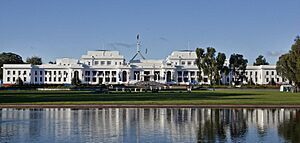
After World War I, a committee was set up. Its job was to get Canberra ready to be the seat of government. This included building a Parliament House. The committee decided to build a temporary building first. They thought it would be used for about 50 years. Then a new, permanent House would be built.
However, Old Parliament House ended up being Parliament's home for 61 years. In its last ten years, the building became very crowded. There was not enough space for everyone.
Designing and Building the New Parliament House
In the first plan for Canberra, Parliament House was meant for Camp Hill. This is between Old Parliament House and Capital Hill. Instead, a "Capitol" building was planned for Capital Hill. It would hold national records and be a public meeting place. The idea was that Parliament would be below the Capitol. This would show that the people were above their representatives. Discussions about the best site continued for years. In 1974, a law was passed that decided Capital Hill would be used.
In 1978, the government decided to build a new Parliament House. It would be on Capital Hill. A special authority was created to manage the construction. A design competition was announced. It received 329 entries from 29 countries.
The winning design came from Mitchell/Giurgola Architects. The main architect on site was Romaldo Giurgola. His design involved burying most of the building under Capital Hill. A huge spire topped with a large Australian flag would sit on top. This spire follows the shape of the triangular Capitol building that was first imagined. The building's outside walls also look a bit like the Old Parliament House. This creates a small link, even though the new building is much bigger.
Giurgola focused on how the building looked. He had a landscape architect guide the engineers. This was unusual for Australia at the time. Experts from the Australian National Botanic Gardens helped choose plants. The building was designed to last 200 years.
Building started in 1981. It was meant to be ready by Australia Day, 26 January 1988. This was the 200th anniversary of European settlement in Australia. The cost was expected to be $220 million. But neither the deadline nor the budget was met.
Queen Elizabeth II opened the building on 9 May 1988. This date was special. It was the anniversary of the first Federal Parliament opening in Melbourne in 1901. It was also when the Provisional Parliament House in Canberra opened in 1927.
The flag on the 81-metre flagpole is 12.8 by 6.4 metres. That's about half the size of a tennis court. The flagpole weighs 250 tonnes and is made of shiny stainless steel. It was designed to be the highest point of Parliament House. It is a clear symbol of the national government. You can see it day and night, from inside and outside the building. The flag itself weighs about 15 kilograms.
The Parliament House site covers 80 acres. The building was designed to look like it sits above Old Parliament House from a distance. The new building is four metres higher than the original hill. About one million cubic metres of rock were dug out. This rock was used to fill low areas in the city. Most of the granite used came from Australia. Twice the amount needed was quarried to ensure very high quality.
There was a plan to knock down Old Parliament House. This would create a clear view from the new building to Lake Burley Griffin. But people successfully argued to save the old building. It now holds a parliamentary museum. The original idea was for Parliament House to be open to everyone for free. The big lawns leading to the entrances were meant to show this.
Outside Features of Parliament House
The design of Parliament House has two large curved walls. These walls divide the building into four main parts. These parts are: the main entrance, the House of Representatives, the executive offices, and the Senate. The walls are built into the hill. This makes the building look like it grows out of the land, instead of standing tall over it. People can walk on the grass roofs. This shows that the people are above the government. An 81-metre flagpole with the Australian flag sits on top of the whole building. This flag is the largest in Australia. It measures 6.4 metres by 12.8 metres, which is about the size of a double-decker bus.
Inside Parliament House
Parliament House has 4,700 rooms. Many parts are open for the public to visit. The main entrance area has a marble staircase. It leads to the Great Hall. This hall displays a huge tapestry. It is based on a painting by Arthur Boyd. The House of Representatives room is decorated in green. The Senate room has a red colour scheme. In the middle of the building, between these two rooms, is the Members' Hall. It has a water feature under a glass roof and the large central flag. The public cannot go into this hall, but they can see it from a balcony above. The executive wing holds the cabinet room, the Prime Minister's Office, and other ministers' offices.
The Forecourt Entrance
Visitors enter Parliament House through the forecourt. This area was designed by architect Robert Woodward. It has slowly rising walls on each side. The entrance looks similar to the Old Parliament House, but much bigger. The red gravel and green fountain represent the Australian outback and bush. This area also features a large mosaic called Possum and Wallaby Dreaming. It highlights the long connection Aboriginal people have to the land.
The mosaic is 196 square metres. It was designed by Indigenous Australian artist Michael Nelson Jagamarra. It shows the tracks of native animals moving towards a central circle. This circle represents Canberra as a meeting place. The style is like the traditional sand paintings of the artist's tribe. Three stonemasons spent 18 months to two years cutting 90,000 granite stones by hand. These stones were used to create the artwork.
The Foyer
The main entrance leads into the foyer. This is the grandest and most decorated public space in the building. It shows the importance of the people over their representatives. The floor is made of shiny black and white marble. You can even spot a fossilised ancient prawn in one step. Unlike the open forecourt, the foyer has many grey-green columns. Their colour is like eucalyptus trees. These columns are inspired by ancient temples. They also help visitors find their way around.
To the left and right are two huge staircases. They are modelled after those in the Doge's Palace in Venice. These old European styles show the influence of European culture in Australia. They also represent ancient Greek and Roman ideas of democracy.
Around the room are 20 wooden panels with marquetry designs. They show Australian plants and animals. This again links the building to the land. Six panels show the animal, flower, and bird symbols of each state. Other panels show plants used by Aboriginal people and early settlers.
The Great Hall
The public entrance to Parliament House leads into the Great Hall. This hall represents the time of early European settlement. The rich marble of the foyer changes to soft woods here. The crowded columns become a huge, bright open space. At the end of the hall is a large tapestry. It is based on a painting by Arthur Boyd. The original painting is also in the building. This tapestry also focuses on the land and place, not people.
On the eastern wall of the Great Hall's gallery is an embroidery. It is 15 metres long and 65 centimetres high. It shows early Australian history through changes to the landscape. This happened with the arrival of settlers. Thousands of people worked on small parts of this embroidery. These pieces were then joined together to make the whole artwork.
Important government events often happen here. But the Great Hall is also open for public events, like weddings. The nearby University of Canberra holds its graduation ceremonies here.
The Members' Hall
Below the Great Hall tapestry is a movable wall. It opens to the Members' Hall. This hall has a water feature in its centre. Only people with special security clearance and important visitors can enter this area. Straight ahead from the Members' Hall is the Ministerial Wing. This wing holds the offices of the Prime Minister and other government ministers.
The Members' Hall connects to the House of Representatives and the Senate buildings. These are to the left and right of the main entrance. The public can reach the visitors' galleries and the Main Committee Room from an upper level. Marble staircases from the entrance foyer lead up to this level. There are also 19 committee rooms open to the public. A very secure Cabinet Room is on the ground floor.
The House of Representatives
The House of Representatives is decorated in green. This colour choice is like the British House of Commons. However, the green here is softer. It suggests the colour of eucalyptus leaves or the Australian bush.
The room can seat up to 172 members. It also has space for 240 with extra seating. The press gallery is at the front. Public galleries with 388 seats are on the left and right. Soundproof galleries for school groups are above these. No talking is allowed when members are present.
Cabinet members, called frontbenchers, go to the table to speak. They use an ornate box called the despatch box. These boxes are copies of those used in the UK House of Commons. King George V gave them in 1927 for the opening of the Old Parliament House. They hold forms and religious texts for new members to swear in. Other members, called backbenchers, have a microphone on their desk. They just stand to speak. Backbench members are given a seat at the start of each Parliament. They must speak from "their place."
The table has books with laws Parliament has passed. It also has copies of rules, dictionaries, and records of debates. The clerk and deputy clerk sit in front of the Speaker. They ring bells during a vote. In front of the clerk are hourglasses. The outer ones measure four minutes, and the middle one measures one minute. These are turned during a vote. One four-minute glass is turned, and bells ring throughout the building. All 2600 clocks in the building flash green for a House vote. They flash red for a Senate vote. The bells ring for four minutes. This gives members time to reach the chamber. After the hourglass stops, doors are locked. Members vote by moving to the government side or the opposition side. If there are more votes without debate, the one-minute hourglass is used.
Like other Westminster parliaments, the governing party sits to the Speaker's right. The Opposition sits to the Speaker's left. Independent members and smaller parties sit between them. The long benches closest to the despatch boxes are for the Cabinet (government side) and the Shadow Cabinet (opposition side). Uniquely, the Prime Minister and Opposition Leader sit separately at the central table, facing each other. The main table was a gift from the Canadian House of Commons. The table for recording debates was a gift from South Australia.
The Senate
The Senate chamber is decorated in red. This matches the colour scheme of the House of Lords. But the red here is softer, like the colours of the outback.
There are currently 76 senators. The chamber was designed for 120 senators. The public viewing areas are almost the same as in the House of Representatives. Unlike the House of Representatives, only the leader of the government or opposition in the Senate goes to the lectern to speak. Other senators use a desk microphone. As you can see, there is no difference between front and back benches in the Senate. Ministers and their opposition counterparts sit on the same two-seat benches as all other senators. The press gallery is above the Senate chamber.
The main officer of the Australian Senate is the President of the Senate. They sit in a similar position to the Speaker in the House of Representatives. Behind the President's seat are two large chairs. These are used when Parliament opens. The bigger chair is for the governor-general. The smaller one is for important guests, like leaders from other countries.
The Parliament House Art Collection has over 6,000 artworks. This includes portraits of every prime minister, governor-general, and speaker. It also has other important Australian artworks.
The Basement
Underneath Parliament House, there is a network of basements and offices. A bomb shelter was first planned for the building. But it was not built due to costs. A large room in the basement was meant to be turned into a bomb shelter, but this has not happened.
Events at Parliament House
The new Parliament House is a major place for events in Canberra. It hosts many of the nation's biggest and most important functions. Parliament House is used for meetings, conferences (both government and private), celebrations, and other events. It is one of the few parliament houses in the world where private events are allowed. Parliament House has 14 event spaces that can be used for special occasions.
Solar Power Project
In 2011, a solar power system was installed on the roof of Parliament House. It was a pilot project with 43.3 kilowatts of power. The system is split into two parts. There are 192 panels on the Senate wing. The other 42 panels are on the roof of the Gardeners' Compound. When it was built, this system was one of the largest for solar power in Australia.
The system started working in June 2011. It has provided enough power for lighting in both the House of Representatives and the Senate. This saves about $9,000 each year. This saving is expected to grow to $17,000 annually.
The system won an award in 2012. It was for "Best design and installation of a grid-connect power system greater than 10 kW."
Engineering Heritage Award
Both the old and new Parliament House have received an award. It is called an Engineering Heritage National Marker. This award comes from Engineers Australia.
See also
 In Spanish: Parliament House para niños
In Spanish: Parliament House para niños
- Centre Block, where Canada's federal parliament meets
- Parliament House, Wellington, where New Zealand's national parliament meets
- United States Capitol, where the United States of America's federal legislature meets
- Palace of Westminster, where the United Kingdom's parliament meets
- Reichstag building, where Germany's federal parliament meets
- National Diet Building, where Japan's national legislature meets



